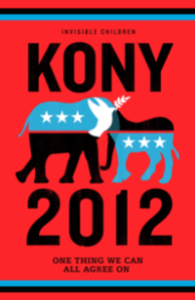Invisible Children closes before mission is completed
BROOKLYN DIPPO
ASST. FEATURE EDITOR
@brooklyndippo
Make Joseph Kony famous overnight, check. That was the first goal of the San Diego based non-profit Invisible Children. With a 29-minute, emotionally charged YouTube short film that has been viewed over 100 million times, the team of young activists had successfully begun their movement.
Joseph Kony is the leader of the Lord’s Resistance Army (LRA), a radical group in Africa that is responsible for displacing over two million Ugandans and abducting thousands of children, 66,000 of whom became child soldiers. Kony was indicted by the International Criminal Court for war crimes and crimes against humanity but has not been captured.
When recent college graduates Jason Russell, Bobby Bailey, and Laren Poole visited Uganda in 2003 they got footage of and interviews from displaced children who were hiding from Kony and the LRA, and that is where Invisible Children began.
The production talent of the founders is unparalleled, but their skills in managing the non-profit were heavily criticized.
Despite the good intentions of nonprofits, they are not immune to failing as a business. And when a non-profit fails, those who were dependent on it are left hopeless once again.
In the case of Invisible Children, there were signs that the non-profit was not good at business.
Footage released of Russell, one of the co-founders, naked and screaming obscenities in the streets of San Diego just 10 days after the video was released was only the beginning of the downward spiral.
It was publicly reported that Russell was put on psychiatric hold before making a public apology but the movement lost the momentum it needed for its “Cover the Night” campaign, the call to action in the documentary, in the midst of bad publicity. On April 20, 2012, six weeks after the video was released, the campaign was a flop.
Critics were quick to attack both the content of the viral video and the spending allocations of Invisible Children, which any non-profit should be prepared for.
The first criticism was that the “Kony 2012” viral video used a substantial amount of old footage from as early as 2003 and presented it as if it were the situation in Uganda in 2012. It also was considered highly biased in its oversimplification of the conflict.
Many nonprofits are criticized for how they spend donations and Invisible Children was no exception. Because nonprofits are required to disclose their finances to anyone who asks, they are easy targets for critics.
Invisible Children raised $5 million dollars in 48 hours following the release of the documentary. Most donors believed that the money they gave would be going directly to aid in Uganda. However, financial statements pointed in a different direction. The majority of the non-profit’s expenses were dedicated to raising awareness and lobbying, and they took out a pretty penny for salaries too. In 2012, over $2 million dollars were spent on salaries alone.
Cameron Brown, a University of San Diego student who volunteered with Invisible Children for seven years said there are benefits to both media and groundwork spending.
“As for whether the groundwork is more beneficial or their fundraising and awareness raising efforts stateside, it’s difficult to say,” Brown said. “They go hand in hand. Without the awareness and fundraising done here, programs like the ones they have there wouldn’t be possible. So in terms of immediate aid, the groundwork programs are definitely better. But those programs can’t be established without the efforts they do stateside.”
The non-profit was never supposed to last as long as it did. The goal of Invisible Children was to capture Kony by the end of 2012 and to begin closing down after that. Kony has not yet been forced to answer for his atrocities but the non-profit was not a total failure.
Invisible Children was successful in raising awareness and getting policymakers to prioritize Uganda on the political agenda. Since 2012, three of the five commanders of the LRA have been captured and over 90 percent of LRA violence has been stopped.
Brown volunteered on the U.S. side of the organization but said that the organization had a well-organized response to resolving LRA conflict in Africa. Invisible Children set up radio towers for early warning of raids, dropped defection fliers encouraging members of the LRA to abandon the group, built rehabilitation centers for children who had been kidnapped, and set up schools with mentoring programs.
“Their groundwork in Uganda, CAR, DRC, South Sudan, etcetera was multifaceted,” Brown said. “They help with all steps in dealing with the LRA.”
After a cutback down to 22 employees at the beginning of 2014, Invisible Children announced that they would be phasing out all of their U.S. employees including the executive board in 2015. Invisible Children is handing their work over to local programs in Africa that aid victims of the LRA and keeping only a few lobbyists working in the states. Invisible Children is running one last campaign to raise $150,000 to fund the transition.
A statement on the Invisible Children website makes it clear that the movement is not over even though the funding has dissolved.
“We’re not quitting, because we won’t stop until every captive man, woman, and child is out of the LRA,” the website said.
The closing of Invisible Children and their mass-media technique is an interesting case in the nonprofit world.
Focusing on groundwork may be more helpful to victims of the LRA but one thing is certain, people will recognize the name Kony for years to come.
